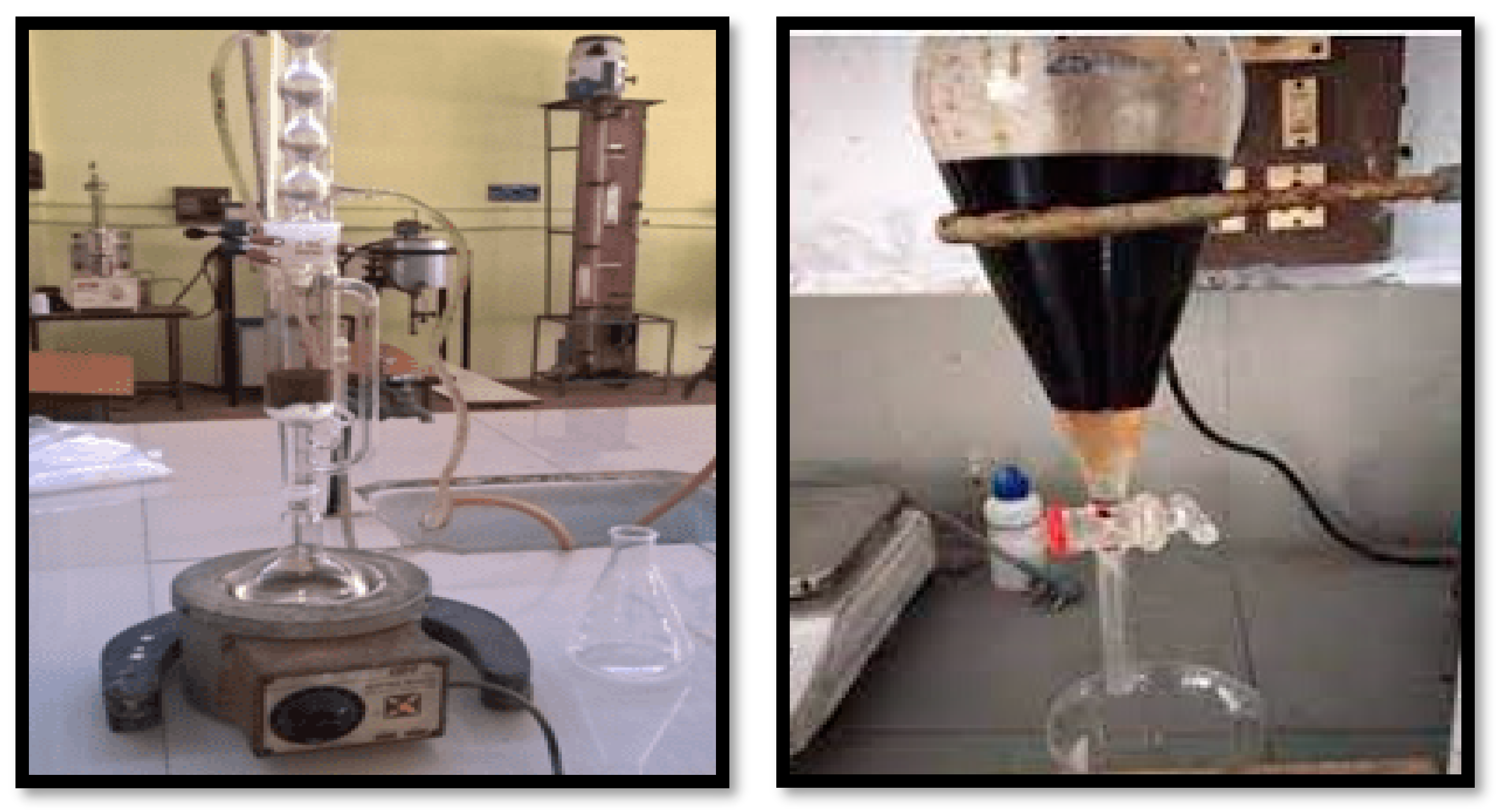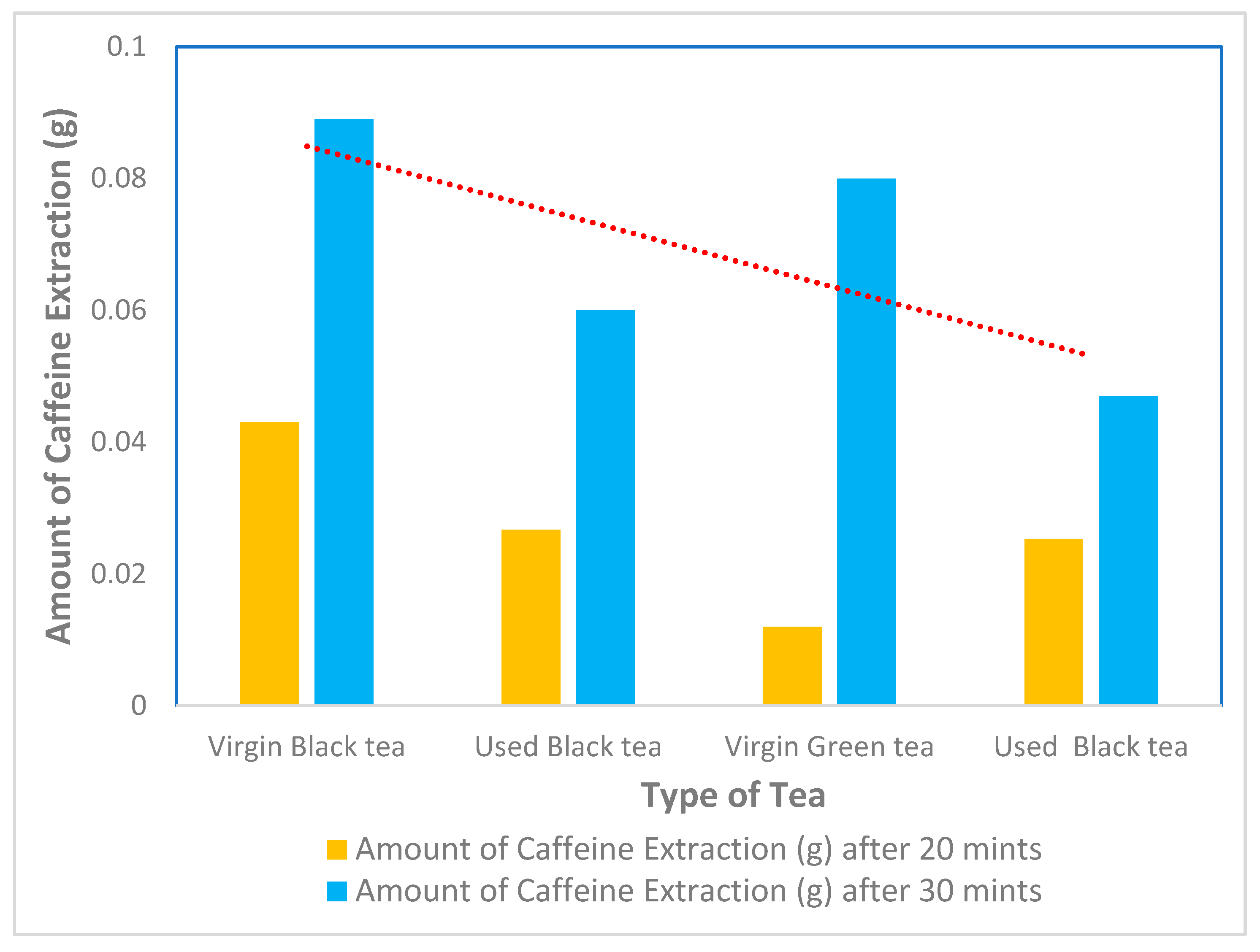Optimization of Caffeine Extraction from Various Tea Types Using Dichloromethane as an Organic Solvent †
Abstract
1. Introduction
2. Material and Methodology
2.1. Materials
2.2. Caffeine Extraction
3. Result and Discussion
3.1. Effect of Temperature
3.2. Effect of Residence Time
4. Conclusions
Author Contributions
Funding
Institutional Review Board Statement
Informed Consent Statement
Data Availability Statement
Conflicts of Interest
References
- Depaula, J.; Farah, A. Caffeine Consumption through Coffee: Content in the Beverage, Metabolism, Health Benefits and Risks. Beverages 2019, 5, 37. [Google Scholar] [CrossRef]
- Faudone, G.; Arifi, S.; Merk, D. The Medicinal Chemistry of Caffeine. J. Med. Chem. 2021, 64, 7156–7178. [Google Scholar] [CrossRef] [PubMed]
- Patil, P. Caffeine in Various Samples and Their Analysis with HPLC—A Review. Int. J. Pharm. Sci. Rev. Res. 2012, 16, 76–83. [Google Scholar]
- Temple, J.L.; Bernard, C.; Lipshultz, S.E.; Czachor, J.D.; Westphal, J.A.; Mestre, M.A. The Safety of Ingested Caffeine: A Comprehensive Review. Front. Psychiatry 2017, 8, 80. [Google Scholar] [CrossRef] [PubMed]
- Martínez-López, S.; Sarriá, B.; Baeza, G.; Mateos, R.; Bravo-Clemente, L. Pharmacokinetics of Caffeine and Its Metabolites in Plasma and Urine after Consuming a Soluble Green/Roasted Coffee Blend by Healthy Subjects. Food Res. Int. 2014, 64, 125–133. [Google Scholar] [CrossRef] [PubMed]
- Ghasemzadeh-Mohammadi, V.; Zamani, B.; Afsharpour, M.; Mohammadi, A. Extraction of caffeine and catechins using microwave-assisted and ultrasonic extraction from green tea leaves: An optimization study by the IV-optimal de-sign. Food Sci. Biotechnol. 2017, 26, 1281–1290. [Google Scholar] [CrossRef] [PubMed]
- Sökmen, M.; Demir, E.; Alomar, S.Y. Optimization of sequential super-critical fluid extraction (SFE) of caffeine and catechins from green tea. J. Supercrit. Fluids 2018, 133, 171–176. [Google Scholar] [CrossRef]
- Senol, A.; Aydin, A. Solid–liquid extraction of caffeine from tea waste using battery type extractor: Process optimization. J. Food Eng. 2006, 75, 565–573. [Google Scholar] [CrossRef]
- Gigliobianco, M.R.; Campisi, B.; Vargas Peregrina, D.; Censi, R.; Khamitova, G.; Angeloni, S.; Di Martino, P. Optimization of the extraction from spent coffee grounds using the desirability approach. Antioxidants 2020, 9, 370. [Google Scholar] [CrossRef] [PubMed]
- Román-Montalvo, D.; Sánchez, A.; Lorenzana-Licea, E.; Domínguez, Z.; Matus, M.H. Extraction of caffeine from coffee husk employing choline-based ionic liquids: Optimization of the process and theoretical study on solute-salts interactions. J. Mol. Liq. 2024, 398, 124286. [Google Scholar] [CrossRef]
- Capuci, A.P.S.; Silva, A.C.B.; Malagoni, R.A.; Ribeiro, E.J.; Finzer, J.R.D. Extraction and Crystallization of Caffeine from Coffee Husks (Coffea Arabica Var. Catuaí). Waste Biomass Valor. 2024, 15, 4947–4963. [Google Scholar] [CrossRef]




| Type of Tea | Initial Weight of Tea (g) | Temperature (°C) | Amount Of Caffeine Extraction (g) | Temperature (°C) | Amount of Caffeine Extraction (g) |
|---|---|---|---|---|---|
| Virgin Black tea | 8 | 80 | 0.032 | 100 | 0.089 |
| Used Black tea | 8 | 80 | 0.03 | 100 | 0.06 |
| Virgin Green tea | 8 | 80 | 0.045 | 100 | 0.08 |
| Used Black tea | 8 | 80 | 0.026 | 100 | 0.047 |
| Type of Tea | Initial Weight of Tea (g) | Time (min) | Amount of Caffeine Extraction (g) | Time (min) | Amount of Caffeine Extraction (g) |
|---|---|---|---|---|---|
| Virgin Black tea | 8 | 20 | 0.043 | 30 | 0.089 |
| Used Black tea | 8 | 20 | 0.0267 | 30 | 0.06 |
| Virgin Green tea | 8 | 20 | 0.012 | 30 | 0.08 |
| Used Black tea | 8 | 20 | 0.0253 | 30 | 0.047 |
Disclaimer/Publisher’s Note: The statements, opinions and data contained in all publications are solely those of the individual author(s) and contributor(s) and not of MDPI and/or the editor(s). MDPI and/or the editor(s) disclaim responsibility for any injury to people or property resulting from any ideas, methods, instructions or products referred to in the content. |
© 2024 by the authors. Licensee MDPI, Basel, Switzerland. This article is an open access article distributed under the terms and conditions of the Creative Commons Attribution (CC BY) license (https://creativecommons.org/licenses/by/4.0/).
Share and Cite
Memon, M.M.; Idress, M. Optimization of Caffeine Extraction from Various Tea Types Using Dichloromethane as an Organic Solvent. Eng. Proc. 2024, 67, 81. https://doi.org/10.3390/engproc2024067081
Memon MM, Idress M. Optimization of Caffeine Extraction from Various Tea Types Using Dichloromethane as an Organic Solvent. Engineering Proceedings. 2024; 67(1):81. https://doi.org/10.3390/engproc2024067081
Chicago/Turabian StyleMemon, Mariam Mir, and Muhammad Idress. 2024. "Optimization of Caffeine Extraction from Various Tea Types Using Dichloromethane as an Organic Solvent" Engineering Proceedings 67, no. 1: 81. https://doi.org/10.3390/engproc2024067081
APA StyleMemon, M. M., & Idress, M. (2024). Optimization of Caffeine Extraction from Various Tea Types Using Dichloromethane as an Organic Solvent. Engineering Proceedings, 67(1), 81. https://doi.org/10.3390/engproc2024067081






